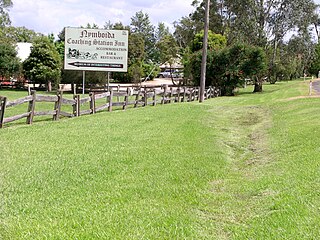
Grafton is a city in the Northern Rivers region of the Australian state of New South Wales. It is located on the Clarence River, approximately 608 kilometres (378 mi) by road north-northeast of the state capital Sydney. The closest major cities, Brisbane and the Gold Coast, are located across the border in South-East Queensland. At the 2021 census, Grafton had a population of 19,255. The city is the largest settlement and, with Maclean, the shared administrative centre of the Clarence Valley Council local government area, which is home to over 50,000 people in all.

Northern Rivers is the most north-easterly region of the Australian state of New South Wales, located between 590 and 820 kilometres north of the state capital, Sydney, and encompasses the catchments and fertile valleys of the Clarence, Richmond, and Tweed rivers. It extends from Tweed Heads in the north to the southern extent of the Clarence river catchment which lies between Grafton and Coffs Harbour, and includes the main towns of Tweed Heads, Byron Bay, Ballina, Kyogle, Lismore, Casino and Grafton. At its most northern point, the region is 102 kilometres (63 mi) south-southeast of the Queensland capital, Brisbane.

Clarence Valley Council is a local government area in the Northern Rivers region of New South Wales, Australia.
Mororo is a small area in the Clarence Valley of New South Wales in Australia. Mororo is dominated by sugar cane farms & does not have a large area of suburbia. The population of Mororo is roughly 40. It is located on the Pacific Motorway and is located in the Bundjalung National Park. Mororo has three residential roads, Banana Road, Lewis Lane, and Mororo Road. It is close to Woombah, Iluka, Maclean, Yamba and Woodburn.

Yamba is a town in the Northern Rivers region of New South Wales, Australia located at the mouth of the Clarence River.

The Clarence River is a river situated in the Northern Rivers district of New South Wales, Australia.

Iluka is a small village at the mouth of the Clarence River in north-eastern New South Wales, Australia. It is situated directly across the river from the resort town of Yamba. At the 2016 census, Iluka had a population of 1,718 people. The town's name is derived from an Aboriginal word meaning "near the sea".

Woodford Island is an inland island in the Far-North Coast of New South Wales, Australia. It is formed by the Clarence River where it splits into the South Arm and North Arm at the small village of Brushgrove then reforms at the town of Maclean. The island is the largest in NSW, either inland or offshore, at 37 km2.

Ulmarra is a small town on the south bank of the Clarence River in New South Wales, Australia in the Clarence Valley district. At the 2006 census, Ulmarra had a population of 446 people.
Lawrence is a small town 13 km from Maclean, New South Wales, Australia. It is accessed by the Lawrence car ferry from Woodford Island or by travelling 30 kilometres north from Grafton. At the 2021 census, the population of Lawrence was 1159.

Woombah is a small but growing bushland village in Clarence Valley, New South Wales, Australia. This hamlet is located to the south of the World Heritage-listed Bundjalung National Park, near the Port of Yamba on Goodwood Island, and 15 minutes from the fishing village of Iluka, New South Wales.
The Bluff Point Ferry, Lawrence is a cable ferry across the Clarence River in New South Wales, Australia. The ferry operates between the town of Lawrence and Woodford Island, and forms part of the route east from Lawrence to the coast. It is the busiest vehicular ferry in New South Wales.
The Daily Examiner is a daily newspaper serving Grafton, New South Wales, Australia. The newspaper is owned by News Corp Australia. At various times the newspaper was known as The Clarence and Richmond Examiner and New England Advertiser (1859–1889) and Clarence and Richmond Examiner (1889–1915).

The Harwood Bridge is a two-lane steel truss bridge which carried the Pacific Highway over the Clarence River in the Northern Rivers region of New South Wales, Australia from 1966 until 2019, when it was replaced by a four-lane 1.5-kilometre-long (4,921 ft) concrete bridge, located 20 metres (66 ft) to its east. The Harwood Bridge has been retained to provide access to Harwood Island.

Nymboida is a rural village in the Northern Rivers region of New South Wales, Australia. It is about 21 kilometres south-west of Coutts Crossing, 44 kilometres south-west of Grafton and approximately 687 km north of Sydney. Nymboida is close to the challenging and popular white water rafting waters of the Nymboida River along the Armidale–Grafton Road. The village is in the Clarence Valley Council local government area.
The Yaygir, Yuraygir, or Yaegl, are an Australian Aboriginal tribe who traditionally live and lived in and around Yamba and Maclean, New South Wales.

Ulgundahi Island is a heritage-listed Aboriginal site, formerly an occupational settlement, with ongoing usage as farmland and as a site of ongoing significance, at Clarence River by North Arm, Maclean, Clarence Valley Council, New South Wales, Australia. The property is owned by the Yaegl Local Aboriginal Land Council. It was added to the New South Wales State Heritage Register on 24 December 2004.
Harwood Shire was a local government area in the Northern Rivers region of New South Wales, Australia.

Harwood is a village on the Clarence River, 5 km north-east of Maclean in northern New South Wales. As of the 2016 census, Harwood had a population of 291. It is known for sugar cane production, with the Harwood Sugar Mill located on the eastern side of town.
The Lower Clarence Magpies are an Australian rugby league football club based in Yamba, New South Wales. The club was founded as Maclean in 1915, later becoming Lower River. They rebranded again as Lower Clarence when they joined the newly formed Group 1 competition in 1966.















